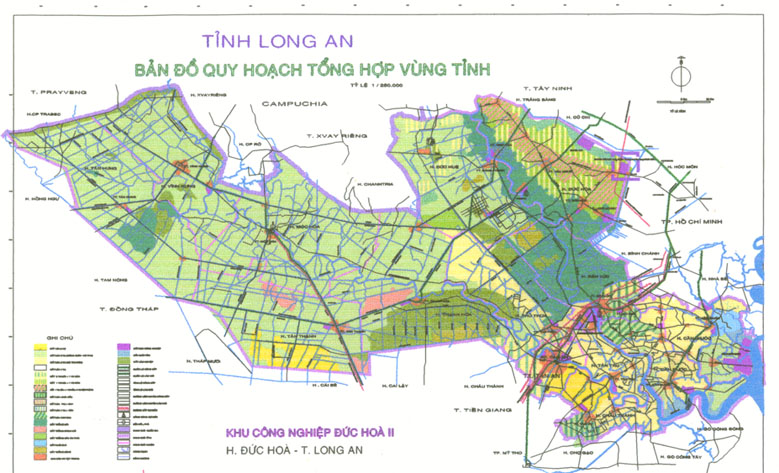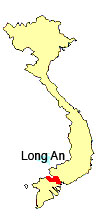
| Long An
Province: A Growing Option for Factory Relocation
The province has a total area of just over 4,400
square kilometers and a total population of about 1.4 million of which
900,000 are laborers. Tan An is the province capital and other
major cities include Ben Luc, Duc Hoa and Thanh Hoa and Moc Hoa
District. Despite the
provinces Western border abutting Ho Chi Minh City which has led many
factories to recently consider it as a site for factory relocation the
province is still much less developed than Binh Duong and/or Dong Nai
which also border Ho Chi Minh City and received much of the early waves
of investment into Vietnam. Despite this, with a very
advantageous location and improving industrial zone infrastructure,
Long An is destined to grow strongly over the years ahead.
Real industrial take-off for Long An started in 2002 after Ho Chi Minh City started moving about 30,000 polluting industrial and craft production businesses from the inner city to suburban locations.
Many Ho Chi Minh City plastic manufacturers have relocated to Long An’s industrial zones. Additionally there has been a considerable influx of Hong Kong and Taiwanese companies that have chosen Long An and one of its industrial parks as their location to process agricultural products for either domestic consumption or for export. According to Long An Industrial Zones Authority there are currently 110 foreign companies already operating in Long An. Of these 60% are Taiwanese with other major investors being from Thailand, France, the U.K. and Korea. Total investment of these foreign firms currently exceeds $1 billion and is growing rapidly. Production of shoes, clothing and plastics are the largest manufacturing industries province wide.
The key advantage of this province for a potential investor seems most easily grasped as a base for agricultural products processing. Cargill (the huge U.S. food processor) has invested $25 million in Ben Luc in a food processing plant for animal feed and other food products. Japfa, another major feed mill processor from Thailand, also has a major facility in the province that we observed. The largest factory in terms of workforce in the province is Ching Luh Company, which has 30,000 workers producing shoes for Addidas and Nike in Ben Luc. Second largest, again in terms of employment, is Formosa Taffeta, which produces fabric and textiles and totally has over 8,600 workers. The third largest manufacturer in terms of employment in De Vuong (Emperor Company, Ltd.) a Taiwanese shoe producer, which has a workforce of 5,000 laborers.
The province has also been simplifying administrative procedures and adopted a one-stop shop – a service common to better-run industrial parks in Vietnam. It takes 3 days to issue an industrial license once you have your paperwork complete. The province has good access to electricity and there are five suppliers of telephone, ADSL and other services. Major industrial parks in the province include Viet Hoa Industrial Park - Duc Hoa 3, Thai Hoa - Duc Hoa 3, Anh Hong - Duc Hoa 3, SILICO - Duc Hoa 3, Thanh Duc, Duc Hoa 1 - Hanh Phuc, Duc Hoa 2, Tan Duc, Vinh Loc 2, Tan Kim and Nhut Chanh.
My assessment on Long An is that there is considerable opportunity here particularly for agriculture related processing and activities like shoe processing, textiles, etc. I believe this could be a good site for Thai companies involved in food processing as a good alternate location to their own country but also think that there are opportunities for U.S. and other companies as well. I definitely would advise a visit and consideration of Long An as a potential site. Land prices appear on the high side compared to those in Binh Duong and also infrastructure is still less developed than in Binh Duong. Further, there are several issues that are currently limiting the province's industrial zone development. One is a regulation that limits the creation of new industrial zones. The regulation states that before establishing a new industrial zone, the existing industrial zones must be at least 50 percent occupied. Many believe that this regulation no longer meets present development requirements as the different business goals and nature of the companies leads them to widely different business models and investment goals. Picture: Master Plan of Long An Economic Zone  About the Author: Christopher W. Runckel, a former senior US diplomat who served in many counties in Asia, is a graduate of the University of Oregon and Lewis and Clark Law School. He served as Deputy General Counsel of President Gerald Ford’s Presidential Clemency Board. Mr. Runckel is the principal and founder of Runckel & Associates, a Portland, Oregon based consulting company that assists businesses expand business opportunities in Asia. (www.business-in-asia.com) Until April of 1999, Mr. Runckel was Minister-Counselor of the US Embassy in Beijing, China. Mr. Runckel lived and worked in Thailand for over six years. He was the first permanently assigned U.S. diplomat to return to Vietnam after the Vietnam War. In 1997, he was awarded the U.S. Department of States highest award for service, the Distinguished Honor Award, for his contribution to improving U.S.-Vietnam relations. Mr. Runckel is one of only two non-Ambassadors to receive this award in the 200-year history of the U.S. diplomatic service. |
|
|
www.Business-in-Asia.com
